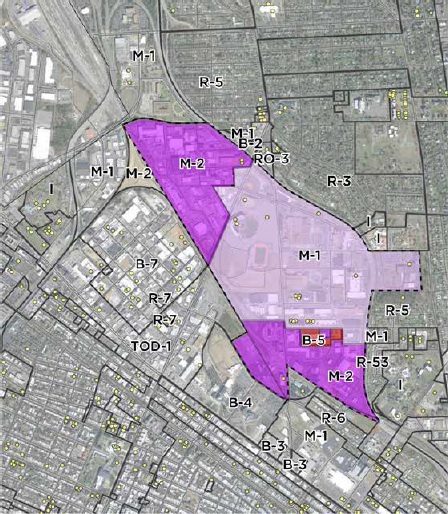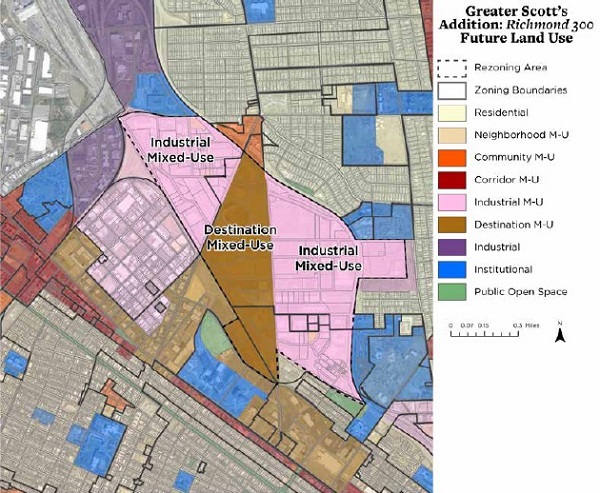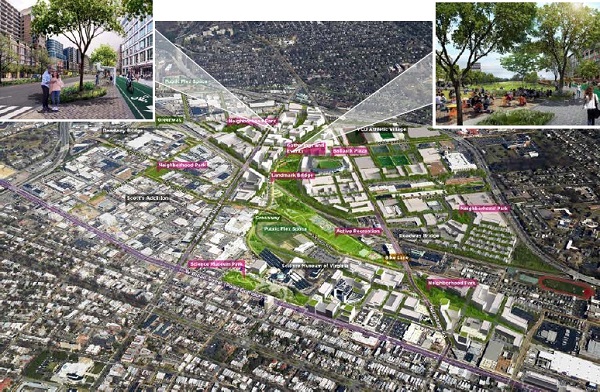The first zoning changes proposed under the city’s new 20-year master plan received a mixed reception from area real estate developers and property owners in an initial presentation earlier this month.
City planners held the first of two scheduled community meetings on the rezoning proposed for what they’re tentatively calling “Greater Scott’s Addition” – primarily industrially-zoned areas north of Scott’s Addition proper and across Arthur Ashe Boulevard north of the railroad tracks, including properties around The Diamond and the Hermitage Road corridor southwest of the interstate.
The rezoning would change the bulk of those properties to B-7 Mixed-Use Business District, while the area between Arthur Ashe and Hermitage would change to TOD-1 Transit-Oriented Nodal District. Both designations have been implemented in and around Scott’s Addition, encouraging that area’s transition from an industrial district to a mishmash of apartments, offices and breweries.
Some properties between Hermitage and the interstate could be changed to B-5 Central Business District, which likewise allows for a greater variety of uses. At the same time, the changes would remove some uses currently allowed in the existing M-1 and M-2 industrial districts, as Jason Guillot, a developer with Thalhimer Realty Partners, noted in the meeting.
“There are some uses that the city will take away, such as drive-thru restaurants, that are permitted in the M-1 district,” Guillot said. “Once you a flip a switch, you go from M-1 to B-7 or TOD overnight. In some cases that may not reflect what perhaps the market wants, what businesses want, what neighbors want.
“It might be the correct long-term vision,” he said, “But to change everything overnight, I don’t think, is necessarily fair. Especially when you’re taking away uses that are permitted today by right.”
Guillot said Thalhimer, which is pursuing a retail development called Scott’s Walk on land near The Diamond it purchased over a year ago, said they’ve been fielding interest from restaurants that specifically want drive-thru windows, a demand that has increased over the course of the pandemic.
“We purchased the property last January, well before the land use plan was finalized and accepted,” Guillot said, referring to the 20-year Richmond 300 plan that was finalized last year and adopted in December. “I would just like you guys to take that into consideration.
“I agree with the long-term view, but we can’t sit around and wait for five or 10 years to see if the market starts to accept this vision,” he said. “In fairness to the property owners today, it would be nice to have an option. Because quite frankly, I would choose not to opt into the new zoning and stick with the M-1 that we currently have, versus seeing our rights taken away.”

Existing zoning in the Greater Scott’s Addition area is primarily M-1 and M-2 industrial, with some B-5.
Planners replied that an incremental approach could be considered, encouraging Guillot and others to share such suggestions in a survey tied to the rezoning proposal. That survey is linked on a city webpage detailing the proposal.
Kevin Vonck, the city’s acting planning director, noted that the area has seen an increase in special-use permit requests to allow development or uses not permitted by current zoning. The city has awarded a dozen SUPs in that area since 2000, planners have said.
“There’s been a number of special use permits in this area that show the uses changing, so we are looking at defining that neighborhood and where those things are and what might be appropriate for rezoning categories,” Vonck said. “This is our first attempt. We have to start somewhere.”
Ashley Peace, president of Sauer Properties, was enthusiastic about the changes. The company, which developed the Whole Foods-anchored Sauer Center near Hermitage and Broad, is looking to continue that trend on several vacant or underutilized properties it owns that are currently zoned M-1.
“We would love to implement what the Richmond 300 master plan has outlined for our properties,” Peace said in the meeting. “We’re raising our hand.”
Peace expressed similar support for a separate zoning initiative that was tied to the city’s Pulse Corridor Plan. That initiative, which targeted areas south and east of the Greater Scott’s Addition proposal, was pulled late last year amid opposition from residents about potential building heights.
Vonck said that effort remains a priority for the city and would be revisited, likely with more TOD zoning involved. He also noted City Councilmember Andreas Addison’s recent request to extend TOD zoning farther west along Broad Street from the Scott’s Addition area.
Andrew Basham, a principal with Scott’s Addition-based Spy Rock Real Estate, said the introduction of TOD has benefited that neighborhood by reducing the number of SUP requests being made to the city and the Scott’s Addition Boulevard Association board, of which he is a member.

Future land use designations in Richmond 300 recommend mixed-use development throughout the Greater Scott’s Addition area.
“We were inundated with special-use permit requests as an association, and it really took our eyes and the city planning department’s eyes off the ball with respect to focusing on some of the fundamentals — like road infrastructure, sidewalks, street trees — that are important to creating these successful neighborhoods,” Basham said.
“When the city was able to rezone Scott’s Addition to the B-7 Mixed-Use District, it allowed us and property owners and the broader neighborhood to understand what in fact is allowed to be developed on every piece of property,” he said. “It has taken a lot of the uncertainly out of the process, and I think that’s been very valuable to us.”
Basham acknowledged that Scott’s Addition has faced and continues to face challenges in planning for infrastructure needs and impacts.
He said the recommendations in the Richmond 300 plan would make that process easier for other parts of the city, including the Hermitage Road area, where Spy Rock is leading a mixed-use redevelopment of properties around Hardywood brewery.
“It contemplates all those things, and the zoning allows us and the city to hold the developers of these properties to a standard that will improve, perhaps incrementally, those challenges and those aspects of these projects in this neighborhood,” Basham said, referring to Scott’s Addition proper.
Of the “Greater Scott’s” zoning proposal, he added, “We’re enthusiastic about this.”
A second virtual meeting on the proposal is scheduled at 6 p.m. April 13. Planners are aiming to present the proposal in June to the Planning Commission and City Council, which could vote to approve the rezoning that month.
The first zoning changes proposed under the city’s new 20-year master plan received a mixed reception from area real estate developers and property owners in an initial presentation earlier this month.
City planners held the first of two scheduled community meetings on the rezoning proposed for what they’re tentatively calling “Greater Scott’s Addition” – primarily industrially-zoned areas north of Scott’s Addition proper and across Arthur Ashe Boulevard north of the railroad tracks, including properties around The Diamond and the Hermitage Road corridor southwest of the interstate.
The rezoning would change the bulk of those properties to B-7 Mixed-Use Business District, while the area between Arthur Ashe and Hermitage would change to TOD-1 Transit-Oriented Nodal District. Both designations have been implemented in and around Scott’s Addition, encouraging that area’s transition from an industrial district to a mishmash of apartments, offices and breweries.
Some properties between Hermitage and the interstate could be changed to B-5 Central Business District, which likewise allows for a greater variety of uses. At the same time, the changes would remove some uses currently allowed in the existing M-1 and M-2 industrial districts, as Jason Guillot, a developer with Thalhimer Realty Partners, noted in the meeting.
“There are some uses that the city will take away, such as drive-thru restaurants, that are permitted in the M-1 district,” Guillot said. “Once you a flip a switch, you go from M-1 to B-7 or TOD overnight. In some cases that may not reflect what perhaps the market wants, what businesses want, what neighbors want.
“It might be the correct long-term vision,” he said, “But to change everything overnight, I don’t think, is necessarily fair. Especially when you’re taking away uses that are permitted today by right.”
Guillot said Thalhimer, which is pursuing a retail development called Scott’s Walk on land near The Diamond it purchased over a year ago, said they’ve been fielding interest from restaurants that specifically want drive-thru windows, a demand that has increased over the course of the pandemic.
“We purchased the property last January, well before the land use plan was finalized and accepted,” Guillot said, referring to the 20-year Richmond 300 plan that was finalized last year and adopted in December. “I would just like you guys to take that into consideration.
“I agree with the long-term view, but we can’t sit around and wait for five or 10 years to see if the market starts to accept this vision,” he said. “In fairness to the property owners today, it would be nice to have an option. Because quite frankly, I would choose not to opt into the new zoning and stick with the M-1 that we currently have, versus seeing our rights taken away.”

Existing zoning in the Greater Scott’s Addition area is primarily M-1 and M-2 industrial, with some B-5.
Planners replied that an incremental approach could be considered, encouraging Guillot and others to share such suggestions in a survey tied to the rezoning proposal. That survey is linked on a city webpage detailing the proposal.
Kevin Vonck, the city’s acting planning director, noted that the area has seen an increase in special-use permit requests to allow development or uses not permitted by current zoning. The city has awarded a dozen SUPs in that area since 2000, planners have said.
“There’s been a number of special use permits in this area that show the uses changing, so we are looking at defining that neighborhood and where those things are and what might be appropriate for rezoning categories,” Vonck said. “This is our first attempt. We have to start somewhere.”
Ashley Peace, president of Sauer Properties, was enthusiastic about the changes. The company, which developed the Whole Foods-anchored Sauer Center near Hermitage and Broad, is looking to continue that trend on several vacant or underutilized properties it owns that are currently zoned M-1.
“We would love to implement what the Richmond 300 master plan has outlined for our properties,” Peace said in the meeting. “We’re raising our hand.”
Peace expressed similar support for a separate zoning initiative that was tied to the city’s Pulse Corridor Plan. That initiative, which targeted areas south and east of the Greater Scott’s Addition proposal, was pulled late last year amid opposition from residents about potential building heights.
Vonck said that effort remains a priority for the city and would be revisited, likely with more TOD zoning involved. He also noted City Councilmember Andreas Addison’s recent request to extend TOD zoning farther west along Broad Street from the Scott’s Addition area.
Andrew Basham, a principal with Scott’s Addition-based Spy Rock Real Estate, said the introduction of TOD has benefited that neighborhood by reducing the number of SUP requests being made to the city and the Scott’s Addition Boulevard Association board, of which he is a member.

Future land use designations in Richmond 300 recommend mixed-use development throughout the Greater Scott’s Addition area.
“We were inundated with special-use permit requests as an association, and it really took our eyes and the city planning department’s eyes off the ball with respect to focusing on some of the fundamentals — like road infrastructure, sidewalks, street trees — that are important to creating these successful neighborhoods,” Basham said.
“When the city was able to rezone Scott’s Addition to the B-7 Mixed-Use District, it allowed us and property owners and the broader neighborhood to understand what in fact is allowed to be developed on every piece of property,” he said. “It has taken a lot of the uncertainly out of the process, and I think that’s been very valuable to us.”
Basham acknowledged that Scott’s Addition has faced and continues to face challenges in planning for infrastructure needs and impacts.
He said the recommendations in the Richmond 300 plan would make that process easier for other parts of the city, including the Hermitage Road area, where Spy Rock is leading a mixed-use redevelopment of properties around Hardywood brewery.
“It contemplates all those things, and the zoning allows us and the city to hold the developers of these properties to a standard that will improve, perhaps incrementally, those challenges and those aspects of these projects in this neighborhood,” Basham said, referring to Scott’s Addition proper.
Of the “Greater Scott’s” zoning proposal, he added, “We’re enthusiastic about this.”
A second virtual meeting on the proposal is scheduled at 6 p.m. April 13. Planners are aiming to present the proposal in June to the Planning Commission and City Council, which could vote to approve the rezoning that month.

Why can’t a drive thru fit on the ground level of a multistory building? I’m all for property owners to have rights and I want the AA Boulevard to look great and be more dense/less car-centric.
A drive through on a multi story building seems like a bit of a traffic nightmare for getting in and out of that building.
There are a lot of shopping centers where the end-unit tenant has added a drive-thru (ex: Dunkin’ off Courthouse). Patrons drive around the building via the alley to access it. Since building and parking deck access tends to be direct to the street, the only traffic interfered with would be deliveries and trash collection. That seems like potential for balance between implementing a drive-thru yet not wasting valuable land on a under-utilized low-tax development. The bigger issue would be that these land owners bought and planned for a cheap development but would now be forced into something considerably more expensive… Read more »
Drive-thrus cause lots of access issues for fire protection access, even for one and two story structures.
Perhaps they could just go ahead with the rezoning and then consider granting old uses by SUP? Just reversing the current situation to shape the trajectory of development.
One solution could be to move forward with the rezoning but grant a short term, say 5 years, grandfathering of conducive uses from the original M-1, M-2 zoning designations.
It’s very hard to see that main picture. On another note, painting in green all around buildings where it’s currently asphalt is a slick trick to make this appear more “green.”